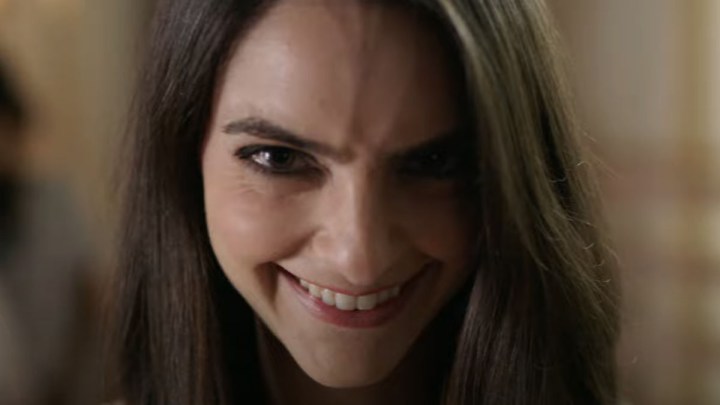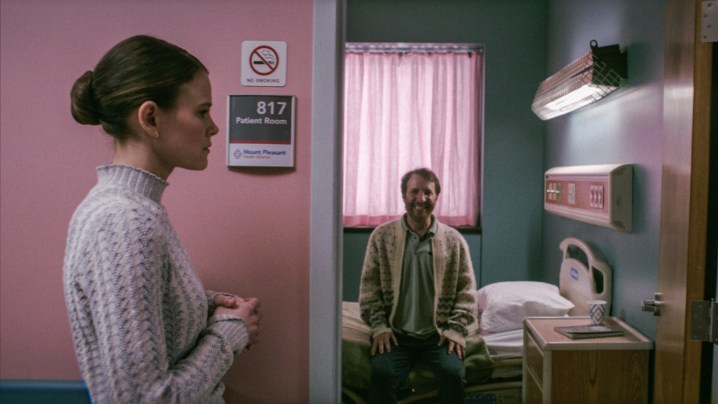Director Parker Finn’s horror feature debut, Smile, has finally premiered in theaters. Based on Finn’s 2020 short film, Laura Hasn’t Slept, this film has been praised for its creative scares, the performances of its cast, and its bold exploration of mental illness. While the movie has been widely compared to horror films like The Ring and It Follows, it has still proven itself to be worth the price of a ticket for many moviegoers. For those who are unsure or scared but still curious, here’s everything audiences need to know about this film all the way to its jaw-dropping ending.
This movie follows Dr. Rose Cotter, a therapist who struggles with the trauma of watching her mentally ill mother die from a drug overdose as a child. As an adult, Rose encounters Laura Weaver, a distraught patient claiming to be stalked by an entity with a wicked smile that only she can see. After Laura kills herself in front of Cotter, while wearing a haunting grin, the traumatized doctor finds herself being targeted by the same evil force, and so she tries to uncover the truth to save herself from a terrible fate.
The smiling entity takes many different forms throughout the film, appearing as people Rose knows, or just as complete strangers. The fact that the creature can also create such realistic illusions makes it even more difficult for Rose to know what is and isn’t real. Rose becomes more and more distressed until almost everyone she knows distances themselves from her, with even her boyfriend and sister not wanting to deal with her supposed delusions and interrupt their “perfect” lives.

However, Rose’s cop ex-boyfriend Joel helps her learn more about the entity, discovering that there is a line of cases of people killing themselves with a smile on their faces a week after witnessing their predecessors do the same. Through their research, Rose and Joel discover a man imprisoned for murder who was cursed by the creature but had managed to evade his own death. When Rose meets with the man, he reveals that the entity craves trauma and that he was able to pass the entity’s curse onto someone else by having them witness him kill someone. This leaves Rose with a real Sophie’s choice: kill someone else or let the entity kill her.
Though Rose has a dream of killing one of her manic hospital patients to pass the curse onto someone else, she realizes that she has to be alone in order to face the entity. Since no one else would be around to witness Rose’s death, the entity would have nowhere else to go. She thus comes face to face with the source of her trauma as she returns to her dilapidated childhood home way out in the countryside. There, she comes face to face with the creature, who takes the form of Rose’s dead mother. Rose admits that she was too scared of her mother to call for help and save her from dying, but she realizes she has to let go of her guilt and move on from her past.

The entity then grows into a large, monstrous version of Rose’s mother, saying that it tormented Rose because her mind was “so willing.” Rose is nearly overpowered by the giant creature, but she gains the upper hand by breaking its arm and setting it ablaze. Rose thus escapes as the house burns to the ground, symbolically walking away from her traumatic past.
The next day, Rose returns to Joel’s apartment and admits the reason why she broke up with him. She explains that she had “forged walls” all her life to prevent people from seeing who she truly was, fearing what they’ll think of her. She became afraid when she saw those walls come down once she met him, showing she suffered a classic “Hedgehog’s dilemma.” But now that she confronted years of embedded trauma, she is finally able to open up.
But when Rose asks if she can stay with Joel, he reveals himself to be the still-living entity with its signature smile, who says it will always be with her. She then runs out of the apartment to find that she is back in the woods in front of her old house, revealing that it was all an illusion crafted by the monster and that she never even left.

The real Joel arrives on the scene, having tracked down Rose’s location. Knowing that she’ll pass the curse onto Joel if he sees her die, Rose runs back into the house in a panic. Inside, the entity reappears and pins Rose to the floor. As the monster reveals its true form, a giant humanoid beast devoid of flesh bearing countless rows of smiles, it makes its way into Rose’s mouth as it possesses her body.
Joel breaks down the door, but he is too late. He finds Rose in the next room smiling, indicating that she has become fully possessed by the creature. She douses herself with lighter fluid and sets herself on fire, and as Joel watches in horror as Rose burns to death, the monster’s curse passes onto him, starting the cycle of trauma and death all over again. As a wise man once said, “The road to Hell is paved with good intentions.”
In the end, Smile is all about the vicious cycle of trauma, as the entity embodies how it can be passed on to people who witness others suffer the same way. But the film also displays how society continues to stigmatize mental illness by using words like “crazy” or “headcase” and pushing away people who live with it. Though leaving people with mental illness alone and without treatment can be detrimental to their well-being, in an ironic twist, it was by keeping others at a distance that Rose was able to stall the monster’s spread of trauma. And while she was able to confront her inner demons and find some relief, the fact that the entity survives shows how trauma can still follow someone throughout their life.



